BMP3004 - Motivation: Factors, Positive Impact, and Strategies
VerifiedAdded on 2023/06/05
|8
|2051
|376
Report
AI Summary
This report provides a comprehensive analysis of employee motivation, exploring its significance in guiding behavior and achieving organizational goals. It delves into various motivation theories, including Maslow's hierarchy of needs, and differentiates between intrinsic and extrinsic motivation. The report identifies key factors that motivate employees, such as salary, promotion opportunities, and a positive work environment, while also addressing negative factors like bad task experiences and lack of recognition. Strategies to cope with these negative factors, such as providing regular training and fostering open communication, are discussed. The report concludes that motivation is crucial for enhancing employee performance and productivity, ultimately contributing to organizational profitability. Desklib offers a platform to explore similar solved assignments and study resources.
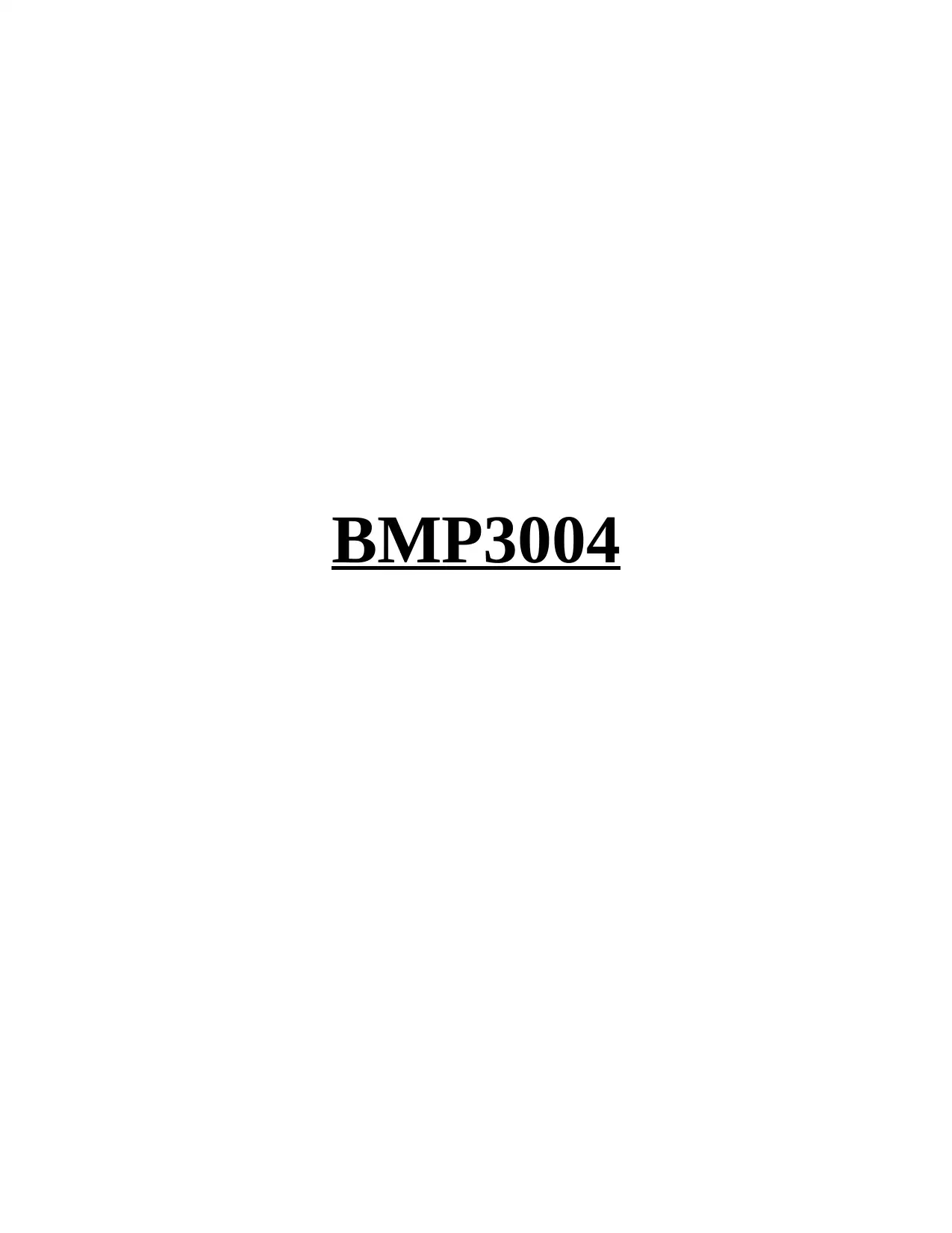
BMP3004
Paraphrase This Document
Need a fresh take? Get an instant paraphrase of this document with our AI Paraphraser
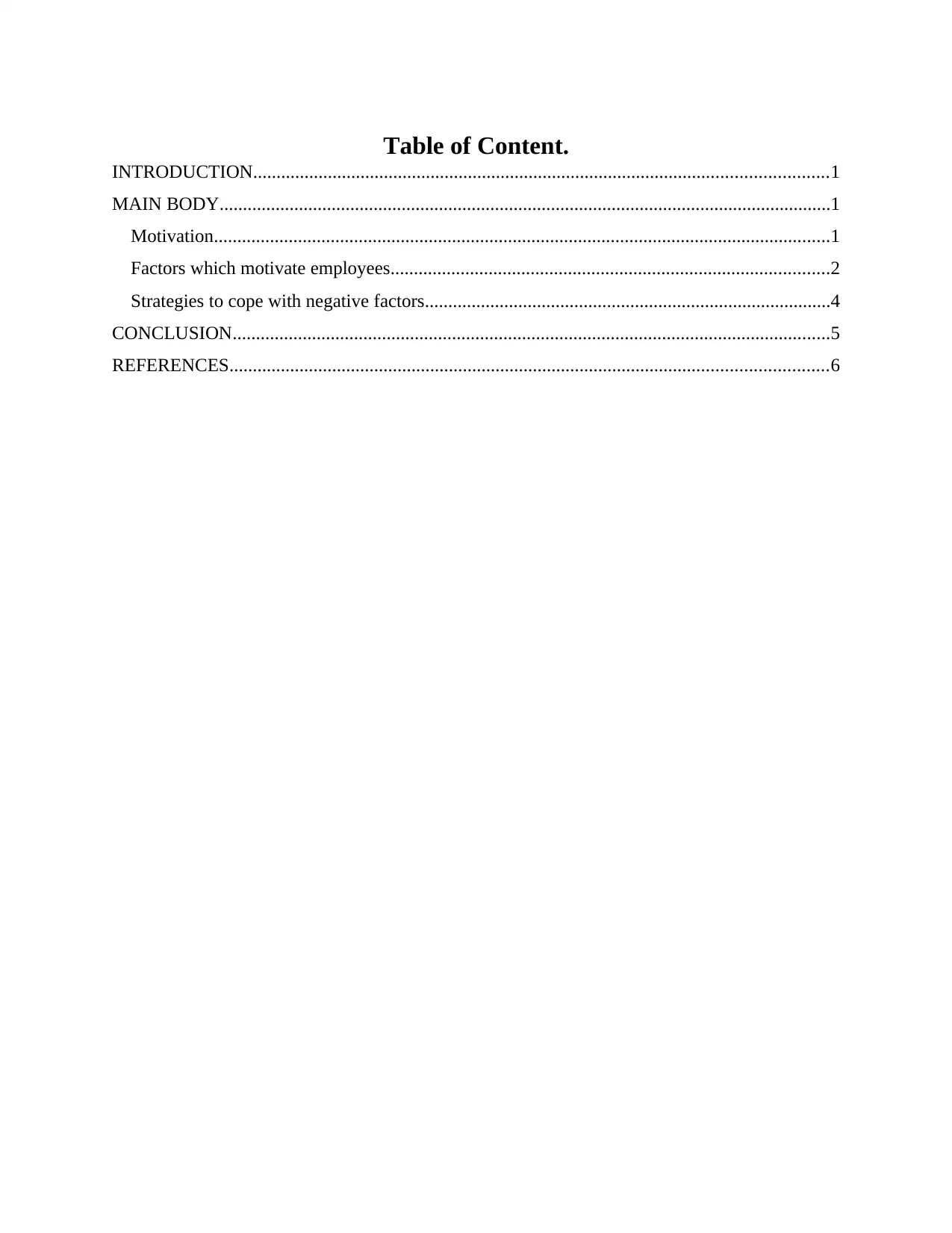
Table of Content.
INTRODUCTION...........................................................................................................................1
MAIN BODY...................................................................................................................................1
Motivation....................................................................................................................................1
Factors which motivate employees..............................................................................................2
Strategies to cope with negative factors.......................................................................................4
CONCLUSION................................................................................................................................5
REFERENCES................................................................................................................................6
INTRODUCTION...........................................................................................................................1
MAIN BODY...................................................................................................................................1
Motivation....................................................................................................................................1
Factors which motivate employees..............................................................................................2
Strategies to cope with negative factors.......................................................................................4
CONCLUSION................................................................................................................................5
REFERENCES................................................................................................................................6
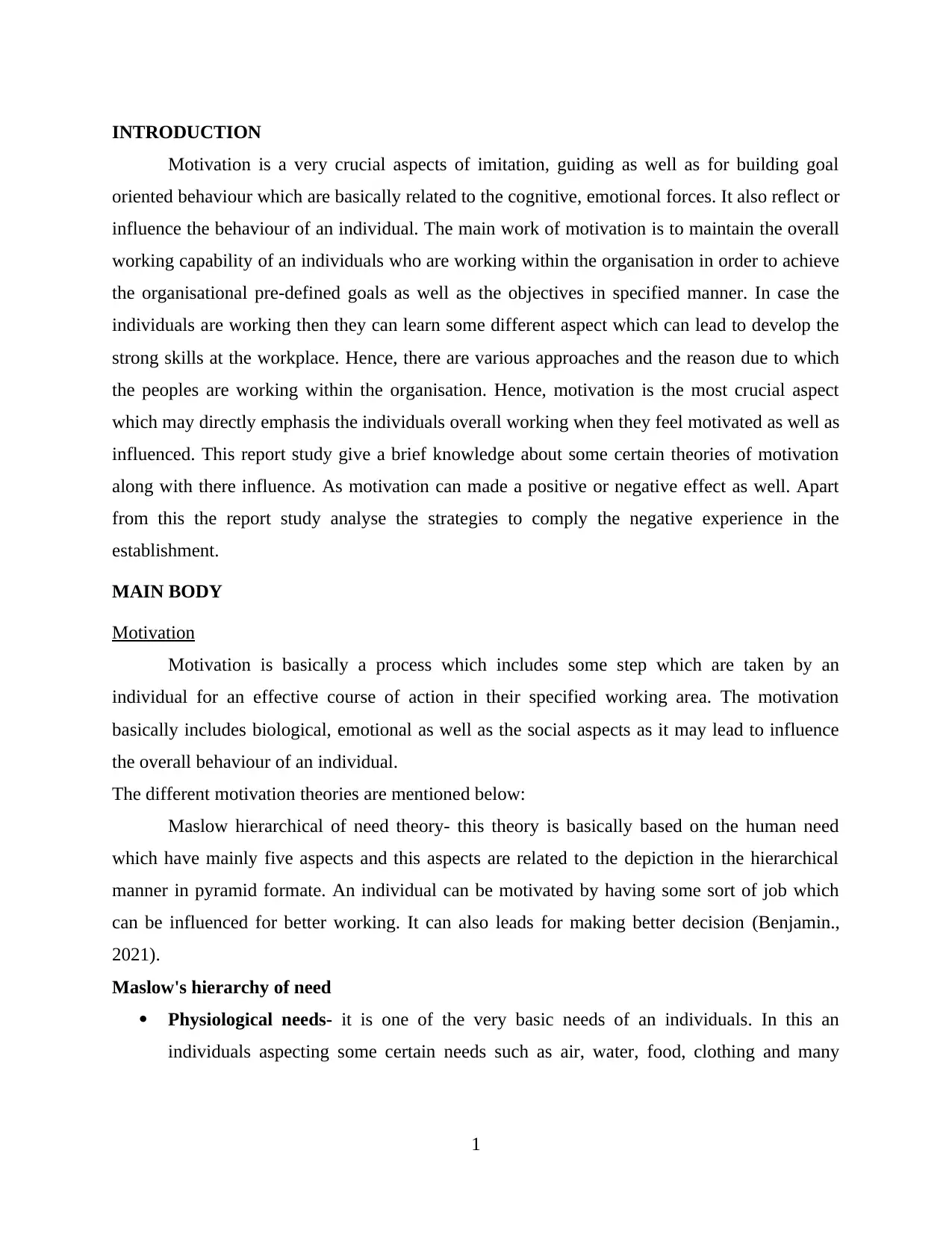
INTRODUCTION
Motivation is a very crucial aspects of imitation, guiding as well as for building goal
oriented behaviour which are basically related to the cognitive, emotional forces. It also reflect or
influence the behaviour of an individual. The main work of motivation is to maintain the overall
working capability of an individuals who are working within the organisation in order to achieve
the organisational pre-defined goals as well as the objectives in specified manner. In case the
individuals are working then they can learn some different aspect which can lead to develop the
strong skills at the workplace. Hence, there are various approaches and the reason due to which
the peoples are working within the organisation. Hence, motivation is the most crucial aspect
which may directly emphasis the individuals overall working when they feel motivated as well as
influenced. This report study give a brief knowledge about some certain theories of motivation
along with there influence. As motivation can made a positive or negative effect as well. Apart
from this the report study analyse the strategies to comply the negative experience in the
establishment.
MAIN BODY
Motivation
Motivation is basically a process which includes some step which are taken by an
individual for an effective course of action in their specified working area. The motivation
basically includes biological, emotional as well as the social aspects as it may lead to influence
the overall behaviour of an individual.
The different motivation theories are mentioned below:
Maslow hierarchical of need theory- this theory is basically based on the human need
which have mainly five aspects and this aspects are related to the depiction in the hierarchical
manner in pyramid formate. An individual can be motivated by having some sort of job which
can be influenced for better working. It can also leads for making better decision (Benjamin.,
2021).
Maslow's hierarchy of need
Physiological needs- it is one of the very basic needs of an individuals. In this an
individuals aspecting some certain needs such as air, water, food, clothing and many
1
Motivation is a very crucial aspects of imitation, guiding as well as for building goal
oriented behaviour which are basically related to the cognitive, emotional forces. It also reflect or
influence the behaviour of an individual. The main work of motivation is to maintain the overall
working capability of an individuals who are working within the organisation in order to achieve
the organisational pre-defined goals as well as the objectives in specified manner. In case the
individuals are working then they can learn some different aspect which can lead to develop the
strong skills at the workplace. Hence, there are various approaches and the reason due to which
the peoples are working within the organisation. Hence, motivation is the most crucial aspect
which may directly emphasis the individuals overall working when they feel motivated as well as
influenced. This report study give a brief knowledge about some certain theories of motivation
along with there influence. As motivation can made a positive or negative effect as well. Apart
from this the report study analyse the strategies to comply the negative experience in the
establishment.
MAIN BODY
Motivation
Motivation is basically a process which includes some step which are taken by an
individual for an effective course of action in their specified working area. The motivation
basically includes biological, emotional as well as the social aspects as it may lead to influence
the overall behaviour of an individual.
The different motivation theories are mentioned below:
Maslow hierarchical of need theory- this theory is basically based on the human need
which have mainly five aspects and this aspects are related to the depiction in the hierarchical
manner in pyramid formate. An individual can be motivated by having some sort of job which
can be influenced for better working. It can also leads for making better decision (Benjamin.,
2021).
Maslow's hierarchy of need
Physiological needs- it is one of the very basic needs of an individuals. In this an
individuals aspecting some certain needs such as air, water, food, clothing and many
1
⊘ This is a preview!⊘
Do you want full access?
Subscribe today to unlock all pages.

Trusted by 1+ million students worldwide
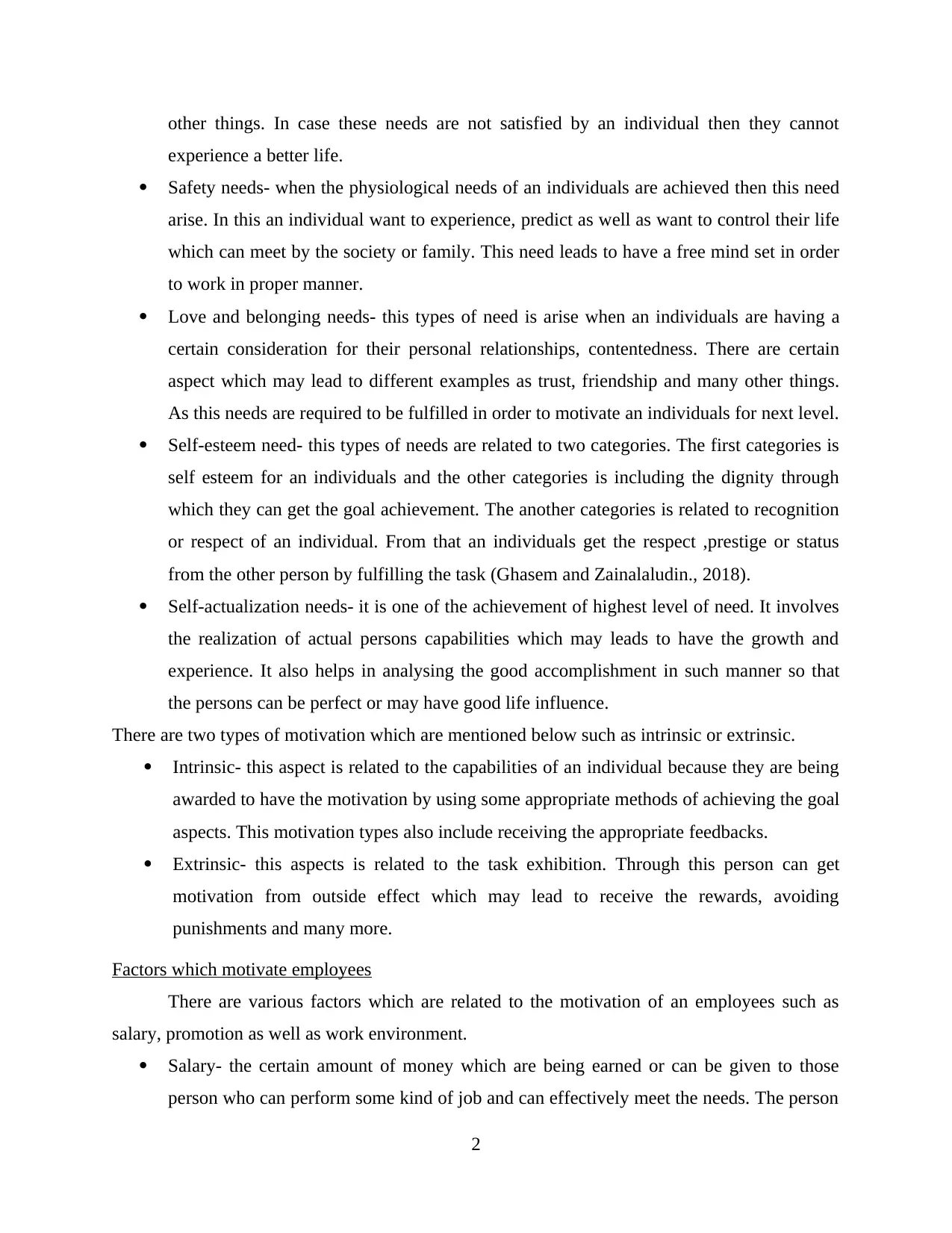
other things. In case these needs are not satisfied by an individual then they cannot
experience a better life.
Safety needs- when the physiological needs of an individuals are achieved then this need
arise. In this an individual want to experience, predict as well as want to control their life
which can meet by the society or family. This need leads to have a free mind set in order
to work in proper manner.
Love and belonging needs- this types of need is arise when an individuals are having a
certain consideration for their personal relationships, contentedness. There are certain
aspect which may lead to different examples as trust, friendship and many other things.
As this needs are required to be fulfilled in order to motivate an individuals for next level.
Self-esteem need- this types of needs are related to two categories. The first categories is
self esteem for an individuals and the other categories is including the dignity through
which they can get the goal achievement. The another categories is related to recognition
or respect of an individual. From that an individuals get the respect ,prestige or status
from the other person by fulfilling the task (Ghasem and Zainalaludin., 2018).
Self-actualization needs- it is one of the achievement of highest level of need. It involves
the realization of actual persons capabilities which may leads to have the growth and
experience. It also helps in analysing the good accomplishment in such manner so that
the persons can be perfect or may have good life influence.
There are two types of motivation which are mentioned below such as intrinsic or extrinsic.
Intrinsic- this aspect is related to the capabilities of an individual because they are being
awarded to have the motivation by using some appropriate methods of achieving the goal
aspects. This motivation types also include receiving the appropriate feedbacks.
Extrinsic- this aspects is related to the task exhibition. Through this person can get
motivation from outside effect which may lead to receive the rewards, avoiding
punishments and many more.
Factors which motivate employees
There are various factors which are related to the motivation of an employees such as
salary, promotion as well as work environment.
Salary- the certain amount of money which are being earned or can be given to those
person who can perform some kind of job and can effectively meet the needs. The person
2
experience a better life.
Safety needs- when the physiological needs of an individuals are achieved then this need
arise. In this an individual want to experience, predict as well as want to control their life
which can meet by the society or family. This need leads to have a free mind set in order
to work in proper manner.
Love and belonging needs- this types of need is arise when an individuals are having a
certain consideration for their personal relationships, contentedness. There are certain
aspect which may lead to different examples as trust, friendship and many other things.
As this needs are required to be fulfilled in order to motivate an individuals for next level.
Self-esteem need- this types of needs are related to two categories. The first categories is
self esteem for an individuals and the other categories is including the dignity through
which they can get the goal achievement. The another categories is related to recognition
or respect of an individual. From that an individuals get the respect ,prestige or status
from the other person by fulfilling the task (Ghasem and Zainalaludin., 2018).
Self-actualization needs- it is one of the achievement of highest level of need. It involves
the realization of actual persons capabilities which may leads to have the growth and
experience. It also helps in analysing the good accomplishment in such manner so that
the persons can be perfect or may have good life influence.
There are two types of motivation which are mentioned below such as intrinsic or extrinsic.
Intrinsic- this aspect is related to the capabilities of an individual because they are being
awarded to have the motivation by using some appropriate methods of achieving the goal
aspects. This motivation types also include receiving the appropriate feedbacks.
Extrinsic- this aspects is related to the task exhibition. Through this person can get
motivation from outside effect which may lead to receive the rewards, avoiding
punishments and many more.
Factors which motivate employees
There are various factors which are related to the motivation of an employees such as
salary, promotion as well as work environment.
Salary- the certain amount of money which are being earned or can be given to those
person who can perform some kind of job and can effectively meet the needs. The person
2
Paraphrase This Document
Need a fresh take? Get an instant paraphrase of this document with our AI Paraphraser
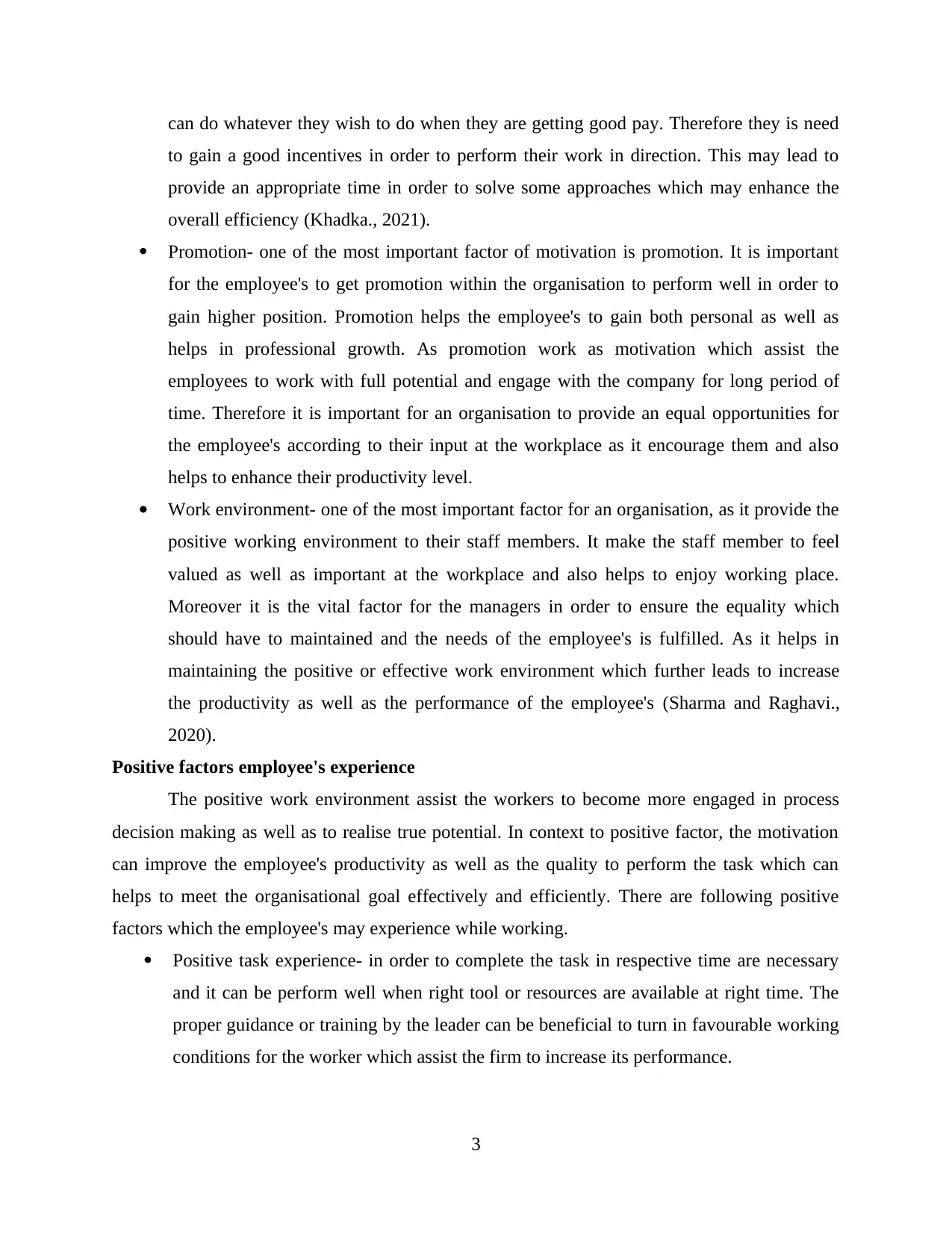
can do whatever they wish to do when they are getting good pay. Therefore they is need
to gain a good incentives in order to perform their work in direction. This may lead to
provide an appropriate time in order to solve some approaches which may enhance the
overall efficiency (Khadka., 2021).
Promotion- one of the most important factor of motivation is promotion. It is important
for the employee's to get promotion within the organisation to perform well in order to
gain higher position. Promotion helps the employee's to gain both personal as well as
helps in professional growth. As promotion work as motivation which assist the
employees to work with full potential and engage with the company for long period of
time. Therefore it is important for an organisation to provide an equal opportunities for
the employee's according to their input at the workplace as it encourage them and also
helps to enhance their productivity level.
Work environment- one of the most important factor for an organisation, as it provide the
positive working environment to their staff members. It make the staff member to feel
valued as well as important at the workplace and also helps to enjoy working place.
Moreover it is the vital factor for the managers in order to ensure the equality which
should have to maintained and the needs of the employee's is fulfilled. As it helps in
maintaining the positive or effective work environment which further leads to increase
the productivity as well as the performance of the employee's (Sharma and Raghavi.,
2020).
Positive factors employee's experience
The positive work environment assist the workers to become more engaged in process
decision making as well as to realise true potential. In context to positive factor, the motivation
can improve the employee's productivity as well as the quality to perform the task which can
helps to meet the organisational goal effectively and efficiently. There are following positive
factors which the employee's may experience while working.
Positive task experience- in order to complete the task in respective time are necessary
and it can be perform well when right tool or resources are available at right time. The
proper guidance or training by the leader can be beneficial to turn in favourable working
conditions for the worker which assist the firm to increase its performance.
3
to gain a good incentives in order to perform their work in direction. This may lead to
provide an appropriate time in order to solve some approaches which may enhance the
overall efficiency (Khadka., 2021).
Promotion- one of the most important factor of motivation is promotion. It is important
for the employee's to get promotion within the organisation to perform well in order to
gain higher position. Promotion helps the employee's to gain both personal as well as
helps in professional growth. As promotion work as motivation which assist the
employees to work with full potential and engage with the company for long period of
time. Therefore it is important for an organisation to provide an equal opportunities for
the employee's according to their input at the workplace as it encourage them and also
helps to enhance their productivity level.
Work environment- one of the most important factor for an organisation, as it provide the
positive working environment to their staff members. It make the staff member to feel
valued as well as important at the workplace and also helps to enjoy working place.
Moreover it is the vital factor for the managers in order to ensure the equality which
should have to maintained and the needs of the employee's is fulfilled. As it helps in
maintaining the positive or effective work environment which further leads to increase
the productivity as well as the performance of the employee's (Sharma and Raghavi.,
2020).
Positive factors employee's experience
The positive work environment assist the workers to become more engaged in process
decision making as well as to realise true potential. In context to positive factor, the motivation
can improve the employee's productivity as well as the quality to perform the task which can
helps to meet the organisational goal effectively and efficiently. There are following positive
factors which the employee's may experience while working.
Positive task experience- in order to complete the task in respective time are necessary
and it can be perform well when right tool or resources are available at right time. The
proper guidance or training by the leader can be beneficial to turn in favourable working
conditions for the worker which assist the firm to increase its performance.
3
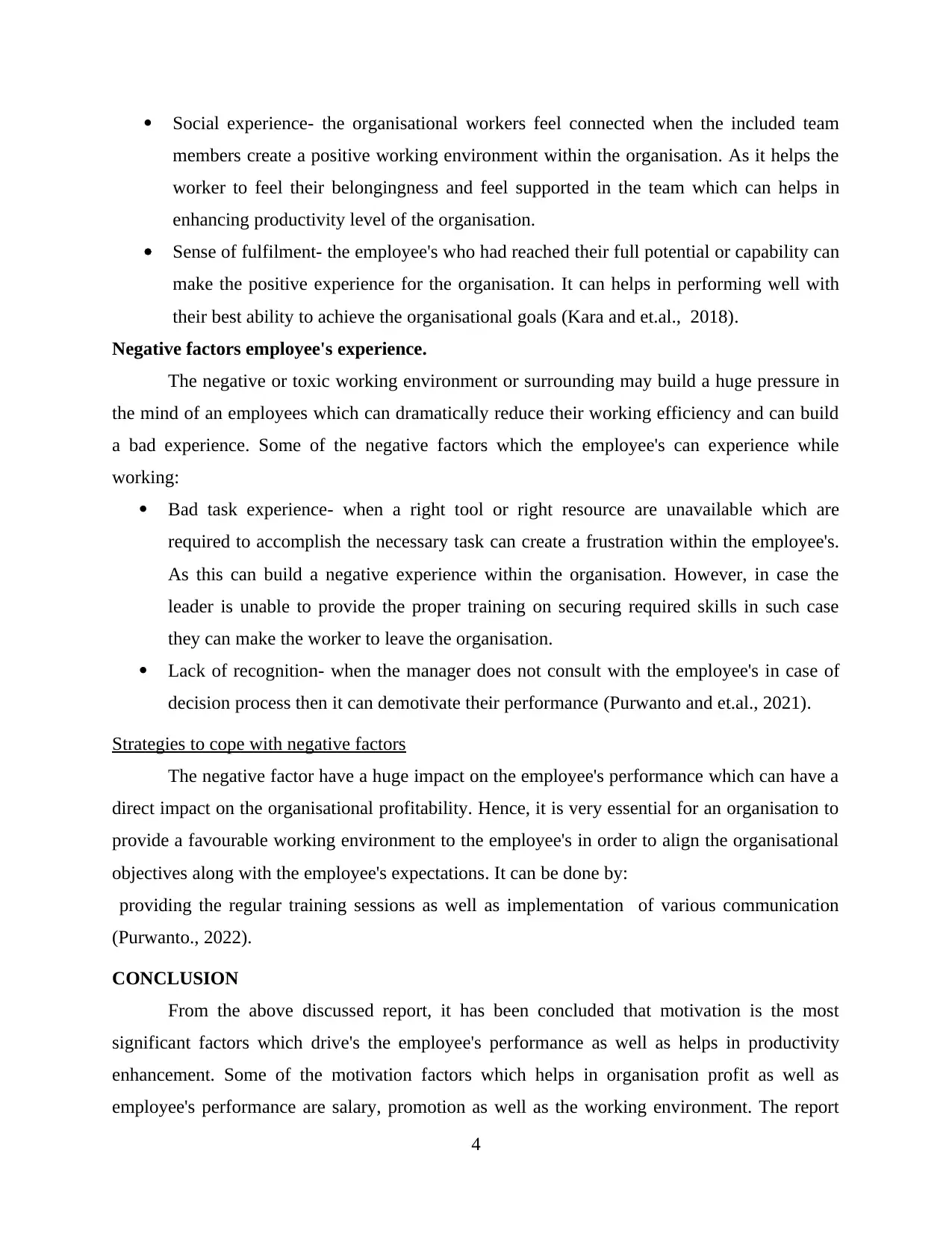
Social experience- the organisational workers feel connected when the included team
members create a positive working environment within the organisation. As it helps the
worker to feel their belongingness and feel supported in the team which can helps in
enhancing productivity level of the organisation.
Sense of fulfilment- the employee's who had reached their full potential or capability can
make the positive experience for the organisation. It can helps in performing well with
their best ability to achieve the organisational goals (Kara and et.al., 2018).
Negative factors employee's experience.
The negative or toxic working environment or surrounding may build a huge pressure in
the mind of an employees which can dramatically reduce their working efficiency and can build
a bad experience. Some of the negative factors which the employee's can experience while
working:
Bad task experience- when a right tool or right resource are unavailable which are
required to accomplish the necessary task can create a frustration within the employee's.
As this can build a negative experience within the organisation. However, in case the
leader is unable to provide the proper training on securing required skills in such case
they can make the worker to leave the organisation.
Lack of recognition- when the manager does not consult with the employee's in case of
decision process then it can demotivate their performance (Purwanto and et.al., 2021).
Strategies to cope with negative factors
The negative factor have a huge impact on the employee's performance which can have a
direct impact on the organisational profitability. Hence, it is very essential for an organisation to
provide a favourable working environment to the employee's in order to align the organisational
objectives along with the employee's expectations. It can be done by:
providing the regular training sessions as well as implementation of various communication
(Purwanto., 2022).
CONCLUSION
From the above discussed report, it has been concluded that motivation is the most
significant factors which drive's the employee's performance as well as helps in productivity
enhancement. Some of the motivation factors which helps in organisation profit as well as
employee's performance are salary, promotion as well as the working environment. The report
4
members create a positive working environment within the organisation. As it helps the
worker to feel their belongingness and feel supported in the team which can helps in
enhancing productivity level of the organisation.
Sense of fulfilment- the employee's who had reached their full potential or capability can
make the positive experience for the organisation. It can helps in performing well with
their best ability to achieve the organisational goals (Kara and et.al., 2018).
Negative factors employee's experience.
The negative or toxic working environment or surrounding may build a huge pressure in
the mind of an employees which can dramatically reduce their working efficiency and can build
a bad experience. Some of the negative factors which the employee's can experience while
working:
Bad task experience- when a right tool or right resource are unavailable which are
required to accomplish the necessary task can create a frustration within the employee's.
As this can build a negative experience within the organisation. However, in case the
leader is unable to provide the proper training on securing required skills in such case
they can make the worker to leave the organisation.
Lack of recognition- when the manager does not consult with the employee's in case of
decision process then it can demotivate their performance (Purwanto and et.al., 2021).
Strategies to cope with negative factors
The negative factor have a huge impact on the employee's performance which can have a
direct impact on the organisational profitability. Hence, it is very essential for an organisation to
provide a favourable working environment to the employee's in order to align the organisational
objectives along with the employee's expectations. It can be done by:
providing the regular training sessions as well as implementation of various communication
(Purwanto., 2022).
CONCLUSION
From the above discussed report, it has been concluded that motivation is the most
significant factors which drive's the employee's performance as well as helps in productivity
enhancement. Some of the motivation factors which helps in organisation profit as well as
employee's performance are salary, promotion as well as the working environment. The report
4
⊘ This is a preview!⊘
Do you want full access?
Subscribe today to unlock all pages.

Trusted by 1+ million students worldwide
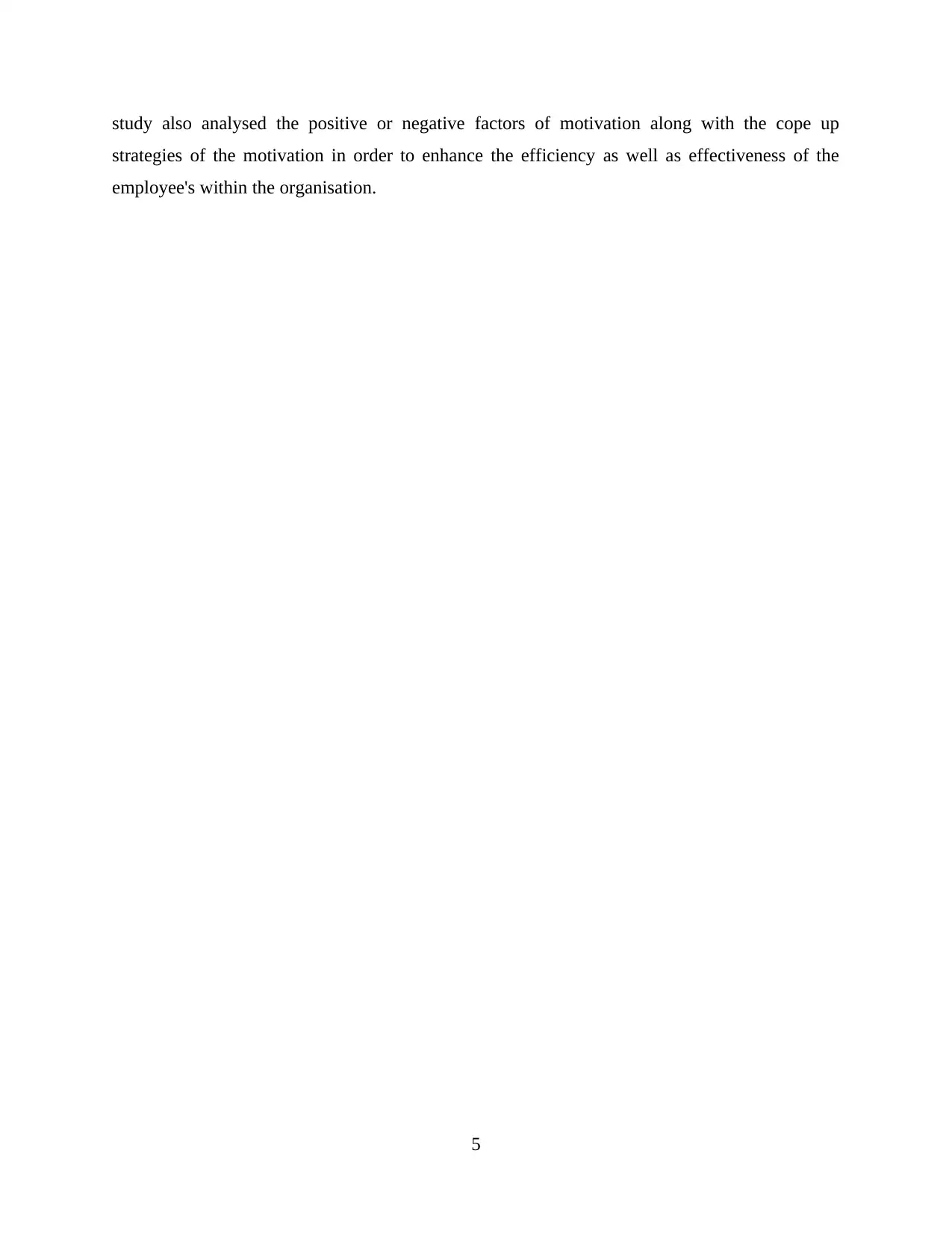
study also analysed the positive or negative factors of motivation along with the cope up
strategies of the motivation in order to enhance the efficiency as well as effectiveness of the
employee's within the organisation.
5
strategies of the motivation in order to enhance the efficiency as well as effectiveness of the
employee's within the organisation.
5
Paraphrase This Document
Need a fresh take? Get an instant paraphrase of this document with our AI Paraphraser
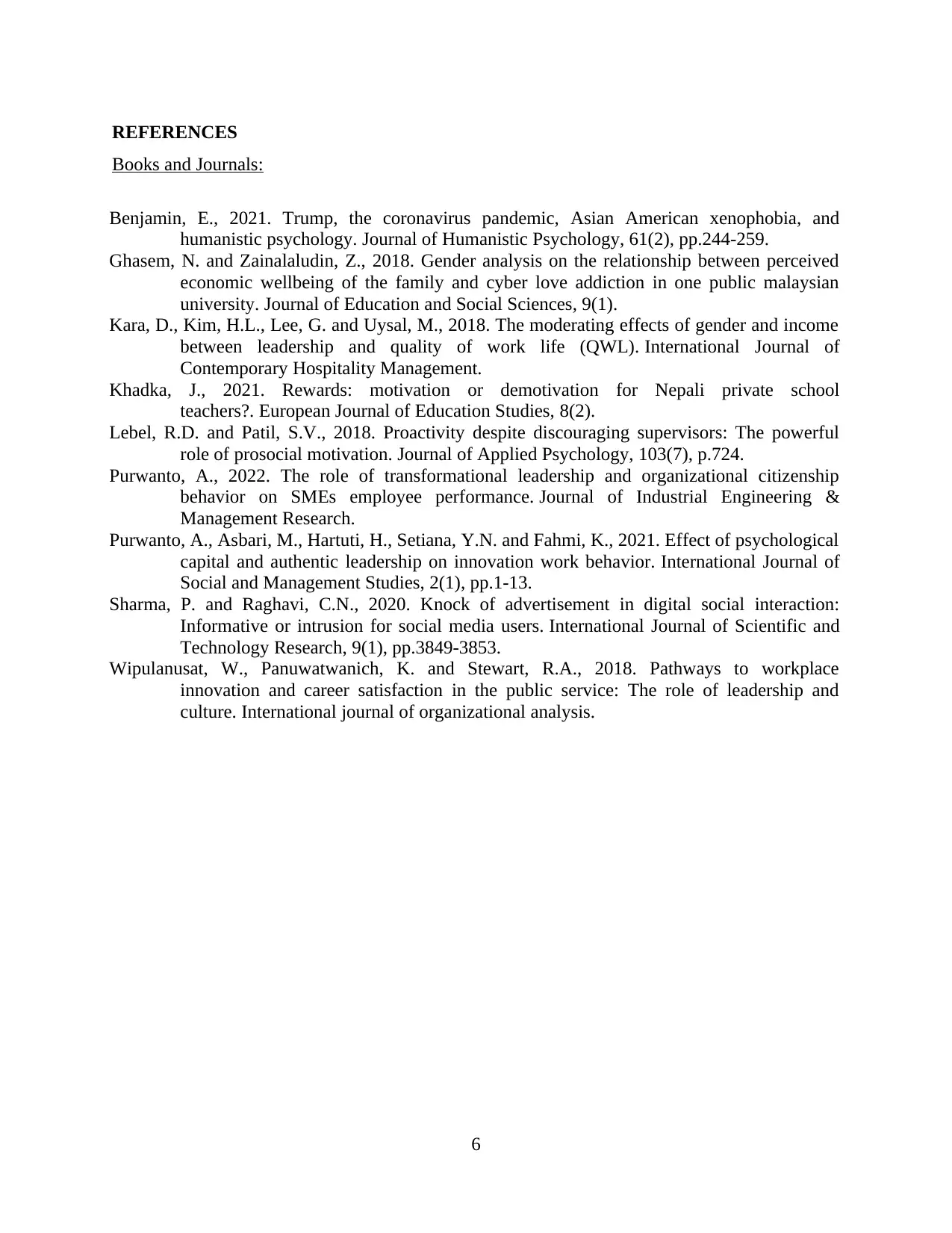
REFERENCES
Books and Journals:
Benjamin, E., 2021. Trump, the coronavirus pandemic, Asian American xenophobia, and
humanistic psychology. Journal of Humanistic Psychology, 61(2), pp.244-259.
Ghasem, N. and Zainalaludin, Z., 2018. Gender analysis on the relationship between perceived
economic wellbeing of the family and cyber love addiction in one public malaysian
university. Journal of Education and Social Sciences, 9(1).
Kara, D., Kim, H.L., Lee, G. and Uysal, M., 2018. The moderating effects of gender and income
between leadership and quality of work life (QWL). International Journal of
Contemporary Hospitality Management.
Khadka, J., 2021. Rewards: motivation or demotivation for Nepali private school
teachers?. European Journal of Education Studies, 8(2).
Lebel, R.D. and Patil, S.V., 2018. Proactivity despite discouraging supervisors: The powerful
role of prosocial motivation. Journal of Applied Psychology, 103(7), p.724.
Purwanto, A., 2022. The role of transformational leadership and organizational citizenship
behavior on SMEs employee performance. Journal of Industrial Engineering &
Management Research.
Purwanto, A., Asbari, M., Hartuti, H., Setiana, Y.N. and Fahmi, K., 2021. Effect of psychological
capital and authentic leadership on innovation work behavior. International Journal of
Social and Management Studies, 2(1), pp.1-13.
Sharma, P. and Raghavi, C.N., 2020. Knock of advertisement in digital social interaction:
Informative or intrusion for social media users. International Journal of Scientific and
Technology Research, 9(1), pp.3849-3853.
Wipulanusat, W., Panuwatwanich, K. and Stewart, R.A., 2018. Pathways to workplace
innovation and career satisfaction in the public service: The role of leadership and
culture. International journal of organizational analysis.
6
Books and Journals:
Benjamin, E., 2021. Trump, the coronavirus pandemic, Asian American xenophobia, and
humanistic psychology. Journal of Humanistic Psychology, 61(2), pp.244-259.
Ghasem, N. and Zainalaludin, Z., 2018. Gender analysis on the relationship between perceived
economic wellbeing of the family and cyber love addiction in one public malaysian
university. Journal of Education and Social Sciences, 9(1).
Kara, D., Kim, H.L., Lee, G. and Uysal, M., 2018. The moderating effects of gender and income
between leadership and quality of work life (QWL). International Journal of
Contemporary Hospitality Management.
Khadka, J., 2021. Rewards: motivation or demotivation for Nepali private school
teachers?. European Journal of Education Studies, 8(2).
Lebel, R.D. and Patil, S.V., 2018. Proactivity despite discouraging supervisors: The powerful
role of prosocial motivation. Journal of Applied Psychology, 103(7), p.724.
Purwanto, A., 2022. The role of transformational leadership and organizational citizenship
behavior on SMEs employee performance. Journal of Industrial Engineering &
Management Research.
Purwanto, A., Asbari, M., Hartuti, H., Setiana, Y.N. and Fahmi, K., 2021. Effect of psychological
capital and authentic leadership on innovation work behavior. International Journal of
Social and Management Studies, 2(1), pp.1-13.
Sharma, P. and Raghavi, C.N., 2020. Knock of advertisement in digital social interaction:
Informative or intrusion for social media users. International Journal of Scientific and
Technology Research, 9(1), pp.3849-3853.
Wipulanusat, W., Panuwatwanich, K. and Stewart, R.A., 2018. Pathways to workplace
innovation and career satisfaction in the public service: The role of leadership and
culture. International journal of organizational analysis.
6
1 out of 8
Related Documents
Your All-in-One AI-Powered Toolkit for Academic Success.
+13062052269
info@desklib.com
Available 24*7 on WhatsApp / Email
![[object Object]](/_next/static/media/star-bottom.7253800d.svg)
Unlock your academic potential
Copyright © 2020–2025 A2Z Services. All Rights Reserved. Developed and managed by ZUCOL.



